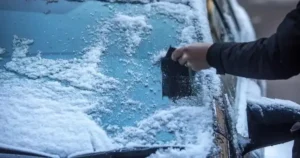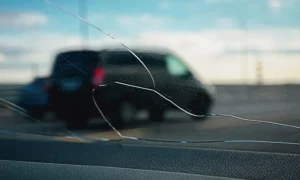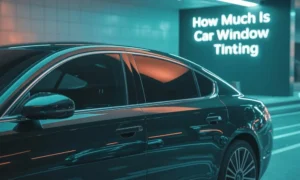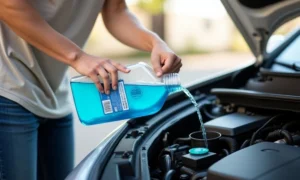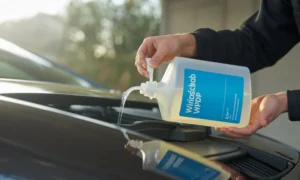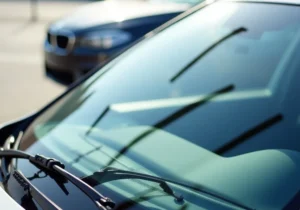Cracked windshield break while driving can pose significant safety hazards for motorists. A cracked windshield not only obstructs visibility but can also compromise the structural integrity of the vehicle during an accident. Addressing these cracks promptly is crucial, as delays can lead to larger repairs and potentially violate local laws regarding vehicle safety standards. Timely intervention not only enhances road safety but also ensures compliance with legal regulations, ultimately protecting both drivers and passengers.
The Risks of Driving with a Cracked Windshield

Impact on Visibility
Cracks in a windshield can severely distort a driver’s vision, creating significant safety hazards. Even small imperfections can scatter light in unpredictable ways, leading to glare and making it difficult to see the road clearly, especially in bright sunlight or at night. This distortion can result in blind spots that impede a driver’s ability to recognize obstacles, pedestrians, or other vehicles in time to react safely.
Statistics highlight the dangers associated with impaired visibility. According to the National Highway Traffic Safety Administration (NHTSA), visibility-related issues contribute to a substantial number of traffic accidents each year. For instance, studies indicate that approximately 25% of all accidents are due to visibility impairment, showcasing how crucial clear sightlines are for safe driving. As such, even minor cracks should not be overlooked, as they can escalate the risk of a collision.
Compromised Structural Integrity
A cracked windshield not only affects visibility but can also compromise the vehicle’s structural integrity. The windshield plays a critical role in reinforcing the vehicle’s frame; it helps maintain the shape of the cabin and supports the roof in the event of a rollover. When a windshield has a crack, its ability to withstand pressure is significantly reduced.
During an accident, the risks increase dramatically. A compromised windshield can fail completely upon impact, which can lead to the deployment of airbags being less effective or even failing altogether. This failure can expose occupants to greater danger, as the windshield is designed to keep debris out of the cabin and protect passengers during a collision. Therefore, a seemingly minor crack can have catastrophic consequences if not addressed in a timely manner.
Legal Consequences
In addition to the safety risks, driving with a cracked windshield can have serious legal implications. Many states and municipalities enforce strict laws regarding vehicle safety, including the condition of windshields. These regulations often specify that a windshield must be free of cracks that could obstruct the driver’s view.
If a law enforcement officer observes a damaged windshield, they can issue citations that may come with fines or penalties. These fines can vary by jurisdiction but can be significant enough to encourage immediate repairs. In some cases, repeat offenders may face more severe penalties, including points on their driving record, which can lead to increased insurance rates or even suspension of driving privileges. Therefore, not only does addressing a cracked windshield enhance safety, but it also helps drivers avoid potential legal troubles.
Windscreen Safety | The Startling Truth About Cracks and Collapse

Types of Cracks and Their Implications
Windscreens can develop various types of cracks, each with distinct implications for safety and repair. The most common types include:
- Star Cracks: These appear as a series of lines radiating from a central point, resembling a star. While they might seem minor, star cracks can quickly grow larger under pressure or temperature changes, leading to a complete windshield failure.
- Bullseye Cracks: Characterized by a circular pattern, bullseye cracks typically occur from a small impact, such as a stone chip. Although they might initially be small, these cracks can compromise the windshield’s integrity and should be repaired immediately to prevent expansion.
- Long Cracks: These are linear cracks that can stretch across the windshield. Long cracks pose a significant risk as they can severely hinder visibility and are more likely to propagate under stress, making immediate repair critical.
Understanding the type of crack present can help drivers assess the urgency of repairs and the potential risks involved in continuing to drive with a damaged windscreen.
Environmental Factors
Environmental conditions can play a significant role in the severity and progression of windshield cracks. Rapid temperature fluctuations, such as moving from a hot car into a cold environment, can cause materials to expand and contract, further stressing existing cracks.
Moisture is another critical factor. Water can seep into cracks, and as it freezes, it expands, potentially worsening the damage. Over time, these environmental factors can exacerbate minor imperfections, leading to larger cracks that may require full replacement rather than simple repairs. Regularly checking for cracks, especially during seasonal changes, can help mitigate these risks.
Long-term Effects of Neglect
Neglecting to address cracks promptly can lead to serious long-term effects. One of the most significant risks is the potential for cracks to spread. As the windshield experiences daily stress from driving—such as vibrations, temperature changes, and impacts from debris—existing cracks can extend and worsen.
The financial implications of delaying repairs can be substantial. Initially, repairing a small crack might cost only a fraction of what a full windshield replacement entails. However, as cracks spread, repair costs increase, and replacement may become the only viable option. Additionally, driving with a compromised windscreen can lead to fines and legal issues, further adding to the financial burden. Therefore, timely action is essential not only for safety but also for managing repair costs effectively.
Cracked Windshield Break While Driving | Contact Repair Professionals
Location of the Crack
- Driver’s Field of Vision: If the crack is directly in your line of sight, it’s critical to address it immediately. This can obstruct your view and increase the risk of an accident.
- Edge vs Center: Cracks closer to the edge of the windshield may be less urgent but can still weaken the structural integrity.
Size of the Crack
- Length: Measure the crack. If it exceeds three inches, it may require a replacement rather than a repair.
- Width: Cracks wider than a quarter may indicate deeper damage.
Visibility
Assess whether the crack obstructs your view of the road. If it does, it’s essential to pull over safely.
Safe Driving Tips if a Crack Occurs While on the Road
- Stay Calm: Keep your composure to maintain control of your vehicle.
- Reduce Speed: Gradually slow down to ensure your vehicle remains stable.
- Avoid Sudden Movements: Steer smoothly to minimize stress on the windshield.
- Pull Over Safely: Look for a safe location, such as a parking lot or wide shoulder, to stop your vehicle.
- Use Hazard Lights: Activate your hazard lights to warn other drivers of your situation.
- Assess the Situation: Once parked, carefully evaluate the severity of the crack as described above.
Contact a Repair Professional
After assessing the situation and ensuring your safety, it’s time to seek professional help.
Contact Reliable Auto Glass
If you’re in the Austin area, Reliable Auto Glass is your go-to solution for windshield repairs and replacements. Our team of experienced technicians can assess the damage and recommend the best course of action to ensure your safety on the road.
- Fast and Reliable Service: We understand that a cracked windshield can be a nuisance. That’s why we prioritize quick and effective repairs.
- Expert Technicians: Our trained professionals use high-quality materials and techniques to restore your windshield.
- Convenient Location: We serve the Austin area, making it easy for you to get the help you need.
You can also read about how much to replace a windshield.
FAQs
What Should I Do If I Experience A Cracked Windshield While Driving?
If you notice a crack while driving, remain calm. Reduce your speed and avoid sudden movements. Look for a safe place to pull over, such as a parking lot or wide shoulder. Once stopped, assess the severity of the crack before contacting a repair professional.
How Can I Assess The Severity Of A Crack In My Windshield?
Assess the crack’s location, size, and type:
- Location: Is it in your line of sight?
- Size: Measure the length; cracks over three inches may need replacement.
- Type: Identify if it’s a star break, chip, or long crack.
Can I Drive With A Cracked Windshield?
Driving with a cracked windshield is not advisable, especially if it obstructs your view. Many states have laws regarding windshield visibility, and driving with a significant crack can lead to fines.
How Does A Cracked Windshield Affect My Safety?
A cracked windshield can compromise the structural integrity of your vehicle, making it less safe in the event of an accident. It can also impede your visibility, increasing the risk of collisions.
What Are The Common Causes Of Windshield Cracks?
Windshield cracks can be caused by:
- Road debris (e.g., rocks or gravel)
- Temperature changes (rapid heating or cooling)
- Poor installation or pre-existing damage
How Quickly Should I Get My Cracked Windshield Repaired?
It’s best to address any windshield damage as soon as possible. Delaying repairs can worsen the damage and lead to more costly replacements.


